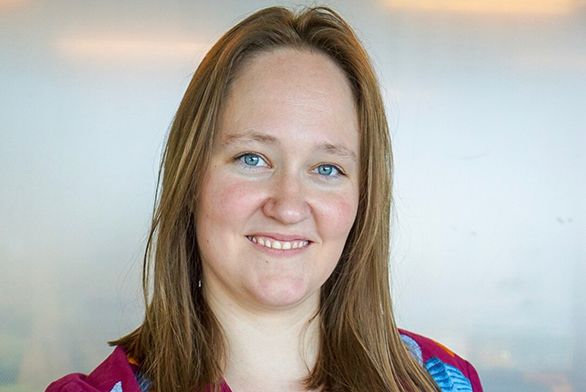Anna Ahern (A06) on Architecture, Vitruvius, and the Federal Reserve
August 6, 2021 | By Les Poling

For Annapolis alum Anna Ahern (A06), a space planning analyst at the Federal Reserve, the thread between St. John’s and her chosen vocation—architecture—is a straightforward one, beginning with Dorothea Brooke’s passion for building better tenant housing in Middlemarch and an impactful preceptorial led by tutor Patricia Locke.
“I am where I am because of St. John’s College,” Ahern explains. “Ms. Locke held a precept my senior year on Vitruvius’s De Architura. At the end, we all wrote essays per the St. John’s way, but we also built models. Our options were ‘any built architecture’—and so I chose the Exeter Library by Louis Kahn, a beautiful library that helped express my love affair with everything geometry.”
“I took that model to the architects in downtown Annapolis and begged for a job. I worked for Michael Dowling for about two to three years and after moved on to grad school at the Boston Architectural College.”
The rest is history. Having been a professional in the field since 2006, including nearly three years as a project architect at Washington, DC-based SKB Architecture & Design, Ahern began working at the Federal Reserve in April 2020, where she channels her architectural background in new and innovative ways—working with the rest of the space planning and management team to orient the Fed’s four buildings to be simultaneously aesthetically appealing and, for the employees occupying those buildings, conducive to enjoyable, effective work.
“We do everything from plan for growth, furnish office space, and hire design teams [to] design for new space,” Ahern says. “I am a planner, organizer, designer. My everyday work is varied: meetings with end user groups, meetings with teams of architects working out design needs, replacing broken task chairs, and more.”
The wide-ranging, unpredictable nature of the work—and the need to synthesize various skills and tasks—harkens back to Ahern’s time at St. John’s. She initially discovered the college via her sister, who walked through the Annapolis campus after a tour of the U.S. Naval Academy, picked up an admissions packet, and gave it to Ahern, telling her, “This is where you should go to college.” At the time, Ahern says, “I was an eternally optimistic, artistic, naive, 17-year-old with intense feeling and unchecked loyalties and ideals … I was contented with living in the middle, assessed only by grades, and allowed myself to be deemed mediocre.”
That all changed when she arrived at St. John’s—first at the Santa Fe campus during her freshman year, and then in Annapolis, where she spent the rest of her undergraduate career after falling in love with rowing (“I loved the balance of intense intellectual work and intense training on the water,” she recalls). The rigor of the Program unlocked a new sense of self: Reading and demonstrating Euclidian proofs, for example, helped Ahern realize that she could solve and understand complex mathematical formulations, despite what she previously believed. It also inspired a still-burning passion for geometry.
“I had significantly more potential than prepping for the SAT would have ever allowed me to realize,” Ahern says. “St. John’s allowed my optimistic, artistic nature to grow and shape the person I am now.”
She continues: “The students and teachers at St. John’s College are part of how I learned to evolve. Classes at St. John’s challenge how you ask questions, how you think and work through an idea, and give you the space to understand deeply how others think, feel, and react to the same subject.”
That sense of constant questioning and intellectual space didn’t only help Ahern realize her own worth; it helped her develop self-assurance and adaptability that have helped her everywhere from Boston Architectural College to the Fed.
“I would not have found my place in the architect community had it not been for St. John’s—I would not have gained the confidence in my mind and being had it not been for St. John’s,” she declares.
Like many Johnnies, Ahern can easily tie her work back to the foundational element of the college: the books.
“Vitruvius describes being an architect as the amateur of everything,” she says. “His idea is that in order to construct and design, you have to have an understanding of math, astronomy, climate, landscape, plumbing, structures, etc.”
In other words, on any given day that Ahern finds herself mapping out an updated wing of an office building, replacing outdated desks and furniture, or working with the design team to meet the needs of Fed employees, she is, in a way, in the same intellectual realm as the Johnnie chair, the seminar table, the books and a balance.
And most importantly, Ahern says, she is the same curious, creative person who first arrived on campus in the mountains of Santa Fe.
“St. John’s allowed me to realize that I didn’t have to change my essential nature to be successful in this world.”

